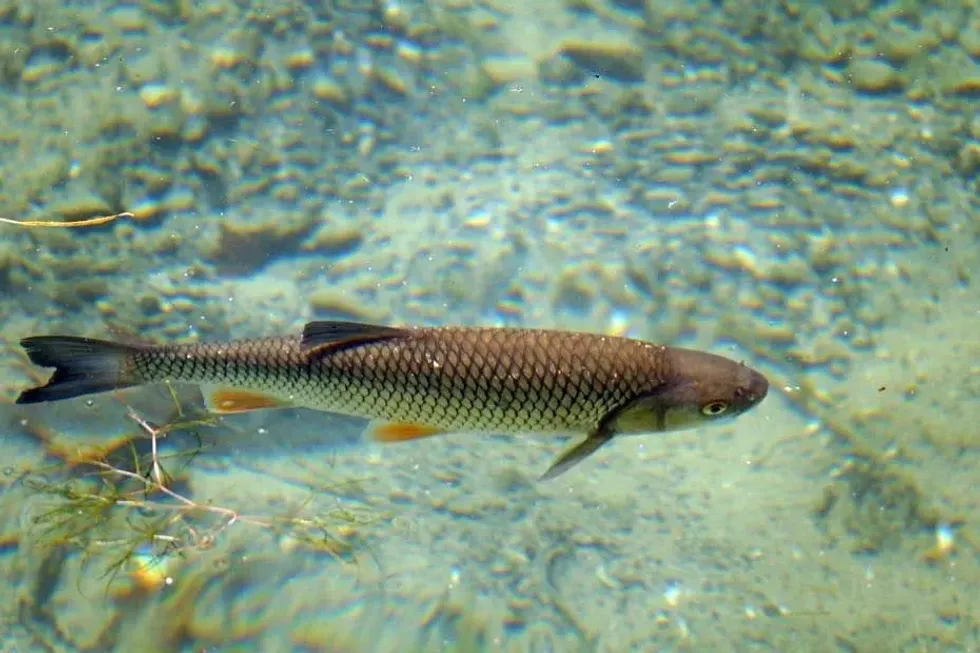Lake whitefish or Coregonus clupeaformis are among the most common and the largest whitefish populations of the Great Lakes. Found in the freshwater lakes, originally in the Great Lakes of North America and Canada, lake whitefish is a deep-bodied fish that is a significant part of commercial fisheries.
Their populations are majorly associated with deep and cold shallow waters, sea beds, and inland lakes.
These silvery sea creatures are covered with scales that range from olive green to light brown coloration on the sides. Their food usually includes shrimps, midge larvae, small fish, clams, and snails.
Lake whitefish is an oviparous sea creature that lays its eggs (spawning) during the early winter season. They have gone through some severe population threats due to fishing and predators such as lake trout, yellow perch, and burbot.
However, the silvery, slimy scales of whitefish helps them to avoid being eaten by these predators. They are consumed by humans on a large scale and are safe for consumption. Whitefish is are caught with the help of live bait and a white jigging spoon in various freshwater lakes and streams in Canada and Alaska.
They are primarily passive in nature. Moreover, whitefish play a significant role in their ecosystem as they are both critical as prey and predator.
Keep on reading to learn more about this fascinating fish. You can also read our articles on angelfish and pilchards.
Lake Whitefish Interesting Facts
What type of animal is a lake whitefish?
Lake whitefish is a type of fish that is a member of the salmon family, also known as Salmonidae.
What class of animal does a lake whitefish belong to?
Lake whitefish belongs to the class of fishes, which is termed Actinopterygii.
How many lake whitefish are there in the world?
Lake whitefish are used for commercial fishing purposes, but due to excessive fishing, habitat loss, and eutrophication, their water bodies get overly enriched with nutrients. This results in the rise of algae and other plant lives and causes a decline in the population of fish and other higher forms of life.
Their populations have declined over the years, especially in the Great Lakes. Despite the decline in population, there is no such authentic number, data, or information currently about this population of this fish in the Great Lakes.
Where does a lake whitefish live?
Lake whitefish lives live in cold freshwater lakes and streams. They are associated with lake beds, inland lakes, and brackish waters. They are found in the Great Lakes and places in Canada and the United States.
What is a lake whitefish's habitat?
Lake whitefish are mainly found in cold, large freshwater lakes and their tributaries or drainage basins. They may enter saline water bodies occasionally.
At times, they migrate amid different depths of water depending upon the season and temperature. They are generally spotted in the depths of water during summer and winter. They return back to shallow waters during spring and then again move towards reefs along lakeshores and rocky shoals.
They prefer to live in a cold water habitat in large numbers in inland lakes. Lake Whitefish are distributed from western Canada to Alaska to the Atlantic drainage of Maine and north of Labrador, New Brunswick.
Who do lake whitefish live with?
Lake whitefish are sociable creatures, and so they are generally found in large schools.
How long does a lake whitefish live?
Lake whitefish have a moderate life expectancy that ranges from 25-50 years (average lifespan) to 50 years in the wild. The mortality rate of this species of fish is higher during the larval stage or at the early stage of eggs.
How do they reproduce?
This These fish of the Great Lakes are oviparous, which means they lay their eggs without any embryonic development within the females. Spawning takes place in the autumn or early winter seasons, mainly during mid-October and December.
They usually lay their eggs in groups.
During spawning, they continuously come near the water's surface or even over the surface with males releasing their sperm cells and ultimately fertilizing the eggs. Generally, females lay their eggs during the night and lay around 10,000 to 130,000 eggs or even more, depending upon their size and capability.
Moreover, this these fish native to the Great Lakes lay their eggs during the early spring season in mid-March or early April.
The eggs take around 133 days to hatch when the temperature is suitable and it is approximately 35.06 F (1.7 C). Once the eggs are fertilized, males and females do not take the responsibility to raise their young ones.
What is their conservation status?
Lake whitefish are not listed in the IUCN or the International Union for Conservation of Nature Red List as per their conservation status. They have a status of Not Evaluated. However, this fish native to the Great Lakes experienced a considerable decline in its populations population due to a history of commercial fishing and habitat loss.
Lake Whitefish Fun Facts
What do lake whitefish look like?
Lake whitefish have scales that are colored from pea green or brown to silvery white. The sides have contrasting features because of their transparent fins and blueish saturation.
They have two dorsal fins, including an adipose fin in male fish that is relatively large. Anal and dorsal fins are 11-12 in (28-30 cm), pectoral fins are 14-17 in (36-43 cm).
Their nose is blunt, and they possess a slender body and a small terminal mouth. Lake whitefish are compressed laterally like a few other salmonids and are long.
Females and males have breeding tubercles in their bodies and on top of their heads. Individuals who are greater than 18 in (45 cm) in length are referred to as mature adults.
Another astonishing fact about lake whitefish is the presence of two tiny flaps in each of their nostrils. The tail has a significant posterior dark edge, and ventral fins are light grey. Their tail fin is forked, which helps them to swim swiftly, thus making them a fast swimmer.
* Please note that this is an image of a salmon, a member of the Salmonidae family. If you have an image of a lake whitefish, please let us know at hello@kidadl.com.

How cute are they?
Lake whitefish are social creatures, but they are not really cute, and they might be considered ugly because of their scales. However, they are demanded in commercial fishing as their flavor is buttery, especially those from the Great Lakes.
How do they communicate?
Lake whitefish are social creatures, and they mostly live in schools. They use a lateral line system which that enables them to detect and sense water movements. Lake whitefish have been reported to communicate with the help of chemical channels primarily.
How big is a lake whitefish?
Lake whitefish are 12-26 in (30-65 cm) in length. This These fish native to the Great Lakes are around two times bigger than sardines.
How fast can a lake whitefish swim?
Lake whitefish are fast swimmers as their tail fin is forked, but their speed has not been evaluated yet.
How much does a lake whitefish weigh?
Lake whitefish weigh around 1.5-4 lb (0.9-1.8 kg). The heaviest recorded weight of a whitefish was 42 lb (19 kg) from Lake Superior in 1918.
What are their male and female names of the species?
There are no such distinctive names for male and female species. Collectively, this fish species is known as lake whitefish.
What would you call a baby lake whitefish?
Young or baby lake whitefishes are known as 'fry'.
What do they eat?
They are carnivores and their primary food sources are shrimps, small fish, clams, and snails.
Are they dangerous?
No, they are not dangerous.
Would they make a good pet?
No, this type of fish cannot be kept in captivity.
Did you know You Know...
Only about 13% of eggs survive and reach larval stage. Moreover, larvae are preyed on by larger predators and fish like sea lamprey, trout, walleye, and salmon.
This whitefish has a the nickname 'humpback' as their heads are small compared to the rest of their body.
Is whitefish safe to eat?
Yes, these are amongst the healthiest fish to eat as they have a high amount of protein and fatty acids such as Omega-3 fatty acids. They taste sweet and delicate and are not firm or tough.
The flavor of this these fish can be described as somewhat buttery, which is the primary reason for them being one of the dominant species in commercial fisheries.
Do whitefish have teeth?
Although they do have small mouths, liked like most of their cousin species, this fish does not have any teeth.
Here at Kidadl, we have carefully created lots of interesting family-friendly animal facts for everyone to discover! Learn more about some other fishes, including sardine or needlefish.
You can even occupy yourself at home by drawing one on our clownfish coloring pages.










